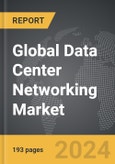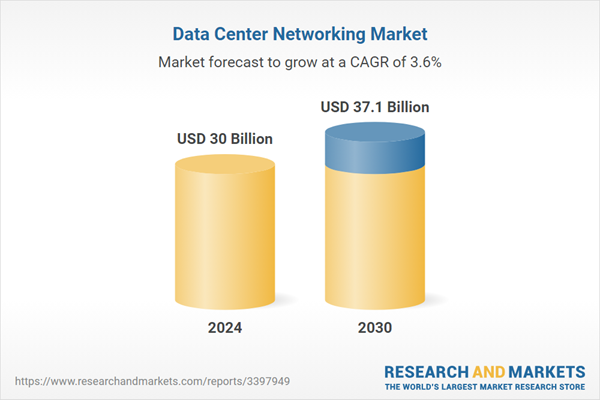The global market for Data Center Networking was valued at US$30.0 Billion in 2024 and is projected to reach US$37.1 Billion by 2030, growing at a CAGR of 3.6% from 2024 to 2030. This comprehensive report provides an in-depth analysis of market trends, drivers, and forecasts, helping you make informed business decisions. The report includes the most recent global tariff developments and how they impact the Data Center Networking market.
The shift from traditional hardware-dependent data center architectures to modern flexible and scalable solutions marks a significant transformation. Traditional networks often faced challenges such as storage limitations and latency issues, compounded by the increasing volume of data. These networks relied heavily on large physical switches and routers, making expansion costly and constrained by physical capacities. Modern data center networking solutions embrace virtualization, allowing applications to function seamlessly across various environments, including public, private, hybrid, and multi-cloud setups. This approach supports a wide range of data services and ensures continuous connectivity for virtual machines, containers, and microservices. Modern networks maintain physical infrastructure components but increasingly integrate software solutions for management and automation, enhancing data and service delivery to end-users.
Several factors drive the growth of data center networking solutions. The increasing use of data-intensive applications such as big data analytics, AI, and IoT necessitates robust and scalable networking infrastructure for rapid data transmission. The adoption of multi-cloud environments requires sophisticated networking solutions to manage and route traffic efficiently across different platforms. The growth of edge computing, which processes data near the source of data generation, impacts data center networking by necessitating more distributed and dynamically managed network resources. Regulatory and compliance requirements drive the adoption of secure and compliant networking solutions to ensure data integrity and confidentiality. The demand for higher energy efficiency pushes data centers to adopt greener technologies that optimize power usage without compromising performance. Advancements in network virtualization and Software-Defined Networking (SDN) offer more flexibility and control over data flows, driving their adoption in modern data centers. Increasing cybersecurity threats necessitate advanced network security solutions, while consumer demand for uninterrupted services influences the adoption of redundant and fault-tolerant network designs. These factors illustrate the complex interaction between technological innovation, regulatory changes, and consumer expectations, shaping the future of data center networking solutions.
Segments: Product (Storage Area Network (SAN), Application Delivery Controllers (ADC), Network Security Equipment, WAN Optimization Equipment, Ethernet Switches, Routers, Other Products); End-Use (IT & Telecom, Government, BFSI, Healthcare, Retail, Manufacturing, Education, Media & Entertainment, Other End-Uses).
Geographic Regions/Countries: World; United States; Canada; Japan; China; Europe (France; Germany; Italy; United Kingdom; Spain; Russia; and Rest of Europe); Asia-Pacific (Australia; India; South Korea; and Rest of Asia-Pacific); Latin America (Argentina; Brazil; Mexico; and Rest of Latin America); Middle East (Iran; Israel; Saudi Arabia; United Arab Emirates; and Rest of Middle East); and Africa.
The analysts continuously track trade developments worldwide, drawing insights from leading global economists and over 200 industry and policy institutions, including think tanks, trade organizations, and national economic advisory bodies. This intelligence is integrated into forecasting models to provide timely, data-driven analysis of emerging risks and opportunities.
Global Data Center Networking Market - Key Trends and Drivers Summarized
Data centers are critical components of modern networking infrastructure, reflecting significant technological advancements and evolving business requirements. With the increasing integration of cloud services, the architecture and operational demands of data centers have transformed, necessitating sophisticated data center networking solutions. These solutions are vital for technicians in Network Operations Centers (NOCs) and data centers, enabling them to monitor various components effectively and address issues promptly. Data center networking involves a complex system of networking resources such as switches, cables, routers, load balancers, and firewalls, which work together to support communication, storage, processing, and security. The primary goal is to establish a secure, reliable, and compliant network that meets user needs and accommodates modern technologies like cloud computing and virtualization.The shift from traditional hardware-dependent data center architectures to modern flexible and scalable solutions marks a significant transformation. Traditional networks often faced challenges such as storage limitations and latency issues, compounded by the increasing volume of data. These networks relied heavily on large physical switches and routers, making expansion costly and constrained by physical capacities. Modern data center networking solutions embrace virtualization, allowing applications to function seamlessly across various environments, including public, private, hybrid, and multi-cloud setups. This approach supports a wide range of data services and ensures continuous connectivity for virtual machines, containers, and microservices. Modern networks maintain physical infrastructure components but increasingly integrate software solutions for management and automation, enhancing data and service delivery to end-users.
Several factors drive the growth of data center networking solutions. The increasing use of data-intensive applications such as big data analytics, AI, and IoT necessitates robust and scalable networking infrastructure for rapid data transmission. The adoption of multi-cloud environments requires sophisticated networking solutions to manage and route traffic efficiently across different platforms. The growth of edge computing, which processes data near the source of data generation, impacts data center networking by necessitating more distributed and dynamically managed network resources. Regulatory and compliance requirements drive the adoption of secure and compliant networking solutions to ensure data integrity and confidentiality. The demand for higher energy efficiency pushes data centers to adopt greener technologies that optimize power usage without compromising performance. Advancements in network virtualization and Software-Defined Networking (SDN) offer more flexibility and control over data flows, driving their adoption in modern data centers. Increasing cybersecurity threats necessitate advanced network security solutions, while consumer demand for uninterrupted services influences the adoption of redundant and fault-tolerant network designs. These factors illustrate the complex interaction between technological innovation, regulatory changes, and consumer expectations, shaping the future of data center networking solutions.
Report Scope
The report analyzes the Data Center Networking market, presented in terms of units. The analysis covers the key segments and geographic regions outlined below.Segments: Product (Storage Area Network (SAN), Application Delivery Controllers (ADC), Network Security Equipment, WAN Optimization Equipment, Ethernet Switches, Routers, Other Products); End-Use (IT & Telecom, Government, BFSI, Healthcare, Retail, Manufacturing, Education, Media & Entertainment, Other End-Uses).
Geographic Regions/Countries: World; United States; Canada; Japan; China; Europe (France; Germany; Italy; United Kingdom; Spain; Russia; and Rest of Europe); Asia-Pacific (Australia; India; South Korea; and Rest of Asia-Pacific); Latin America (Argentina; Brazil; Mexico; and Rest of Latin America); Middle East (Iran; Israel; Saudi Arabia; United Arab Emirates; and Rest of Middle East); and Africa.
Key Insights:
- Market Growth: Understand the significant growth trajectory of the Solution segment, which is expected to reach US$21.9 Billion by 2030 with a CAGR of a 0.4%. The Service segment is also set to grow at 9.8% CAGR over the analysis period.
- Regional Analysis: Gain insights into the U.S. market, valued at $7.6 Billion in 2024, and China, forecasted to grow at an impressive 9.3% CAGR to reach $10.1 Billion by 2030. Discover growth trends in other key regions, including Japan, Canada, Germany, and the Asia-Pacific.
Why You Should Buy This Report:
- Detailed Market Analysis: Access a thorough analysis of the Global Data Center Networking Market, covering all major geographic regions and market segments.
- Competitive Insights: Get an overview of the competitive landscape, including the market presence of major players across different geographies.
- Future Trends and Drivers: Understand the key trends and drivers shaping the future of the Global Data Center Networking Market.
- Actionable Insights: Benefit from actionable insights that can help you identify new revenue opportunities and make strategic business decisions.
Key Questions Answered:
- How is the Global Data Center Networking Market expected to evolve by 2030?
- What are the main drivers and restraints affecting the market?
- Which market segments will grow the most over the forecast period?
- How will market shares for different regions and segments change by 2030?
- Who are the leading players in the market, and what are their prospects?
Report Features:
- Comprehensive Market Data: Independent analysis of annual sales and market forecasts in US$ Million from 2024 to 2030.
- In-Depth Regional Analysis: Detailed insights into key markets, including the U.S., China, Japan, Canada, Europe, Asia-Pacific, Latin America, Middle East, and Africa.
- Company Profiles: Coverage of players such as Amazon Web Services, Inc., Arista Networks, Inc., AT&T, Inc., Avaya, Inc., Berkshire Hathaway and more.
- Complimentary Updates: Receive free report updates for one year to keep you informed of the latest market developments.
Some of the 74 companies featured in this Data Center Networking market report include:
- Amazon Web Services, Inc.
- Arista Networks, Inc.
- AT&T, Inc.
- Avaya, Inc.
- Berkshire Hathaway
- Broadcom Ltd.
- Cisco Systems, Inc.
- Dell Technologies, Inc.
- Delta Electronics, Inc.
- Equinix, Inc.
- Extreme Networks, Inc.
- Facebook, Inc.
- Fujitsu Ltd.
- Google Cloud Platform
- Hewlett Packard Enterprise Development LP (HPE)
- Huawei Technologies Co., Ltd.
- IBM Corporation
- Intel Corporation
- JPMorgan Chase and Co.
- Juniper Networks Inc.
- Microsoft Corporation
- Microsoft Corporation
- NEC Corporation
- Nokia Corporation
- NTT Communications Corporation
- Oracle Corporation
- Schneider Electric SA
- Siemens AG
- Telefonica SA
- Unisys Corporation
- Vmware, Inc.
Tariff Impact Analysis: Key Insights for 2025
Global tariff negotiations across 180+ countries are reshaping supply chains, costs, and competitiveness. This report reflects the latest developments as of April 2025 and incorporates forward-looking insights into the market outlook.The analysts continuously track trade developments worldwide, drawing insights from leading global economists and over 200 industry and policy institutions, including think tanks, trade organizations, and national economic advisory bodies. This intelligence is integrated into forecasting models to provide timely, data-driven analysis of emerging risks and opportunities.
What’s Included in This Edition:
- Tariff-adjusted market forecasts by region and segment
- Analysis of cost and supply chain implications by sourcing and trade exposure
- Strategic insights into geographic shifts
Buyers receive a free July 2025 update with:
- Finalized tariff impacts and new trade agreement effects
- Updated projections reflecting global sourcing and cost shifts
- Expanded country-specific coverage across the industry
Table of Contents
I. METHODOLOGYII. EXECUTIVE SUMMARY2. FOCUS ON SELECT PLAYERSIII. MARKET ANALYSISCANADAITALYSPAINRUSSIAREST OF EUROPESOUTH KOREAREST OF ASIA-PACIFICARGENTINABRAZILMEXICOREST OF LATIN AMERICAIRANISRAELSAUDI ARABIAUNITED ARAB EMIRATESREST OF MIDDLE EASTIV. COMPETITION
1. MARKET OVERVIEW
3. MARKET TRENDS & DRIVERS
4. GLOBAL MARKET PERSPECTIVE
UNITED STATES
JAPAN
CHINA
EUROPE
FRANCE
GERMANY
UNITED KINGDOM
ASIA-PACIFIC
AUSTRALIA
INDIA
LATIN AMERICA
MIDDLE EAST
AFRICA
Companies Mentioned (Partial List)
A selection of companies mentioned in this report includes, but is not limited to:
- Amazon Web Services, Inc.
- Arista Networks, Inc.
- AT&T, Inc.
- Avaya, Inc.
- Berkshire Hathaway
- Broadcom Ltd.
- Cisco Systems, Inc.
- Dell Technologies, Inc.
- Delta Electronics, Inc.
- Equinix, Inc.
- Extreme Networks, Inc.
- Facebook, Inc.
- Fujitsu Ltd.
- Google Cloud Platform
- Hewlett Packard Enterprise Development LP (HPE)
- Huawei Technologies Co., Ltd.
- IBM Corporation
- Intel Corporation
- JPMorgan Chase and Co.
- Juniper Networks Inc.
- Microsoft Corporation
- Microsoft Corporation
- NEC Corporation
- Nokia Corporation
- NTT Communications Corporation
- Oracle Corporation
- Schneider Electric SA
- Siemens AG
- Telefonica SA
- Unisys Corporation
- Vmware, Inc.
Table Information
| Report Attribute | Details |
|---|---|
| No. of Pages | 193 |
| Published | April 2025 |
| Forecast Period | 2024 - 2030 |
| Estimated Market Value ( USD | $ 30 Billion |
| Forecasted Market Value ( USD | $ 37.1 Billion |
| Compound Annual Growth Rate | 3.6% |
| Regions Covered | Global |









